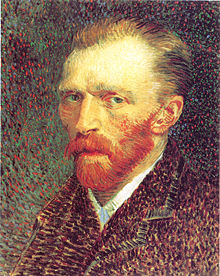Portrait


A portrait is a painting, photograph, sculpture, or other artistic representation of a person, in which the face and its expression is predominant. The intent is to display the likeness, personality, and even the mood of the person. For this reason, in photography a portrait is generally not a snapshot, but a composed image of a person in a still position. A portrait often shows a person looking directly at the painter or photographer, in order to most successfully engage the subject with the viewer.
Some of the earliest portraits of people who were not kings or emperors, are the funeral portraits that survived in the dry climate of Egypt's Fayum district. These are the only paintings of the Roman period that have survived, aside from frescos.
The art of the portrait flourished in Roman sculptures, where sitters demanded realistic portraits, even unflattering ones. During the 4th century, the portrait began to retreat in favor of an idealized symbol of what that person looked like. (Compare the portraits of Roman Emperors Constantine I and Theodosius I at their entries.) In Europe true portraits of the outward appearance of individuals re-emerged in the late Middle Ages, in Burgundy and France.
Moche culture of Peru was one of the few ancient civilizations which produced portraits. These works accurately represent anatomical features in great detail. The individuals portrayed would have been recognizable without the need for other symbols or a written reference to their names. The individuals portrayed were members of the ruling elite, priests, warriors and even distinguished artisans.[1] They were represented during several stages of their lives. The faces of gods were also depicted. To date, no portraits of women have been found. There is particular emphasis on the representation of the details of headdresses, hairstyles, body adornment and face painting.
One of the best-known portraits in the Western world is Leonardo da Vinci's painting titled Mona Lisa, which is a painting of an unidentified woman. The world's oldest known portrait was found in 2006 by a local pensioner, Gérard Jourdy, in the Vilhonneur grotto near Angoulême and is thought to be 27,000 years old.[2]
Contents |
Self-portraiture

When the artist creates a portrait of him- or herself, it is called a self-portrait. Identifiable examples become numerous in the late Middle Ages, but if the definition is extended the first was by the Egyptian Pharaoh Akhenaten's sculptor Bak, who carved a representation of himself and his wife Taheri c. 1365 BC. However, it seems likely that self-portraits go back to the earliest representational art, and literature records several classical examples, now lost.
Portrait photography
Portrait photography is a popular commercial industry all over the world. Many people enjoy having professionally made family portraits to hang in their homes, or special portraits to commemorate certain events, such as graduations or weddings.

Since the dawn of photography, people have made portraits. The popularity of the daguerreotype in the middle of the 19th century was due in large part to the demand for inexpensive portraiture. Studios sprang up in cities around the world, some cranking out more than 500 plates a day. The style of these early works reflected the technical challenges associated with 30-second exposure times and the painterly aesthetic of the time. Subjects were generally seated against plain backgrounds and lit with the soft light of an overhead window and whatever else could be reflected with mirrors.
As photographic techniques developed, an intrepid group of photographers took their talents out of the studio and onto battlefields, across oceans and into remote wilderness. William Shew's Daguerreotype Saloon, Roger Fenton's Photographic Van and Mathew Brady's What-is-it? wagon set the standards for making portraits and other photographs in the field.
Politics
In politics, portraits of the leader are often used as a symbol of the state. In most countries it is common protocol for a portrait of the head of state to appear in important government buildings. Excessive use of a leader's portrait can be indicative of a personality cult.
Literature
In literature the term portrait refers to a written description or analysis of a person or thing. A written portrait often gives deep insight, and offers an analysis that goes far beyond the superficial. For example, American author Patricia Cornwell wrote a best-selling book titled Portrait of a Killer about the personality, background, and possible motivations of Jack the Ripper, as well as the media coverage of his murders, and the subsequent police investigation of his crimes.
See also
- Caricature
- Environmental portrait
- Head shot
- Hidden faces
- Hierarchy of genres
- Painting the Century 101 Portrait Masterpieces 1900-2000
- Portrait painting
- Self-portrait
- The Portrait Now
- The Portrait of a Lady, a novel published in 1881 and a film in 1996
References
- ↑ Donnan, Christopher B. Moche Portraits from Ancient Peru University of Texas Press, 2004. ISBN 0-292-71622-2.
- ↑ "Cave face 'the oldest portrait on record'". The Times (5 June 2006). Retrieved on 2008-01-04.
External links
- National Portrait Gallery of the Smithsonian Institution
- National Portrait Gallery London
- National Portrait Gallery Moscow
- Painting The Century 101 Portrait Masterpieces
- Jeanne Ivy's Self-Portrait Page - What Artists Find When They Search in the Mirror.
- Portrait Detectives - Fun interactive introduction to the analysis of portraiture.
- Reportret - A gallery of reconstructions of missing portraits from world history.